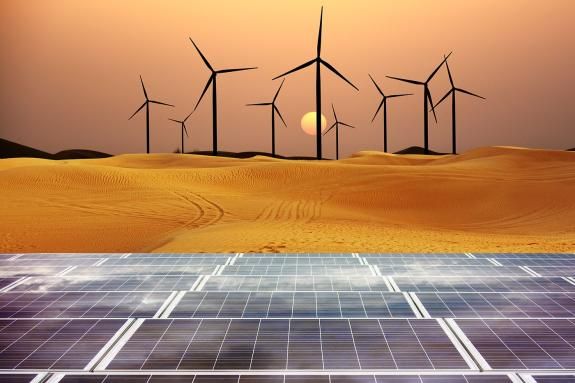
The role of blended financing in a just energy transition
This article was originally published on, and written for Environmental Finance
The current 'poly crisis' presents an opportunity to combine economic and environmental policies allowing sustainable development, write Gustavo Medeiros and Iselin Aslakstrom.
Egypt is a fitting location for the COP27. The large North African country is vulnerable to global warming as well as other multidimensional risks including geopolitical, political, societal, healthcare, balance sheet, fiscal, and monetary policy challenges.
The current 'poly crisis' environment presents an opportunity for international financial institutions (IFIs) to combine economic and environmental policies allowing sustainable development, not only in Egypt but across frontier economies (low-income developing countries with low access to finance).
Egypt's 100 million people are vulnerable to exogenous risks from global warming and more directly the drought risks from filling the Grand Ethiopian Renaissance Dam. If well implemented, the water reservoir in Ethiopia could become a solution to avoid periods of droughts affecting the population downstream in Sudan and Egypt1. Just like the climate change challenge, the filling and management of the dam requires effective coordination between nations.
The recent devastating floods in Pakistan highlight the need to accelerate the energy transition and prioritise sustainable development. In a world already warmed by1.1°C from pre-industrial times, the 1.5°C temperature target seems increasingly unrealistic.
A report published before the COP26 in Glasgow illustrated the crux of the energy transition challenge is that developed countries emit far more than the developing world2. The problem is compounded by developing economies' population growth and their willingness to increase their living standards, which would lead to more greenhouse gases emissions with the current energy matrix. Condemning developing economies to stay poor to deal with climate change is unlikely to succeed.
The solution, in our opinion, is combining economic development with energy transition acceleration. A recent article by Eduardo Porter estimates the world "must move eight times faster" to achieve the net-zero target by 20503. This is possible only if developing countries adopt renewable energy technology on a large scale and leapfrog decades of reliance on fossil fuels.
The challenge is to mobilise long term funding for developing countries to invest in clean energy. The public sector failed to commit significant capital despite the focus on 'just transition' and 'climate equity' principles during the COP25 in Paris.
As a result, the attention turned to mobilising private finance at COP26, and the importance of are calibration of the economic system to become 'aligned with Paris' targets. Combining both, public finance can mitigate risks to private capital via 'blended finance' instruments.
"The IMF should, we believe, require Egypt to develop the insurance and pension industries and provide technical advice to implement a sound regulatory framework for investments in sustainable infrastructure development"
For example, multilateral organisations can develop foreign exchange hedging mechanisms for foreign private capital investing in high-growth frontier countries.
This is particularly important now that renewable energy is cheaper than fossil fuels across most 'energy starved' frontier countries, but local capital markets are underdeveloped, meaning it's impossible to borrow in local currency for the duration of the project, while foreign lenders are only willing to lend in their own currency.
Furthermore, the development of green financial instruments is necessary. A good recent example was the Uruguayan Sovereign Sustainability-Linked Bond (SSLB), an instrument that allows the sovereign to pay lower interest rates if it achieves quantifiable emission targets by 2025, but higher rates if it misses those targets4.
This creates a clear monetary incentive for developing countries to invest in their energy transition targets.
In terms of long-term actions, IFIs must encourage long-term savings that traditionally have higher propensity to be invested in long-term infrastructure projects. The development of defined contributions pension funds and insurance companies is the most effective way of building long-term savings. In our view, every single IFI lending programme should have quantifiable targets for local capital market development.
This takes us back to Egypt. The International Monetary Fund (IMF) just announced its 11th lending facility to Egypt so the country can navigate a balance of payments crisis triggered by poor fiscal management, tighter funding conditions, and higher wheat prices. The IMF should, we believe, require Egypt to develop the insurance and pension industries and provide technical advice to implement a sound regulatory framework for investments in sustainable infrastructure development.
Egypt could also issue SSLBs once it regains access to markets. In the meantime, multilateral organisations could create mechanisms to hedge currency risks in renewable energy (solar power) investments with revenues in Egyptian Pounds.
Using IFIs' capital and know-how to catalyse renewable energy projects could 'invert' the poly crisis vicious cycle faced by Egypt and other frontier countries, into a virtuous cycle of sustainable development that boosts energy availability and economic development alongside accelerating the energy transition pace.
After all, Egypt's future would be worrisome if global warming or geopolitical risks dry up the River Nile, or if its population is not allowed to improve their economic wellbeing and quality of life.
1. See Understanding and managing new risks on the Nile with the Grand Ethiopian Renaissance Dam
2. See Seven policy proposals to meet the Paris Agreement objectives
3. See How to Meet Climate Targets: Leave No Economy Behind
4. See Xi Jinping consolidates power